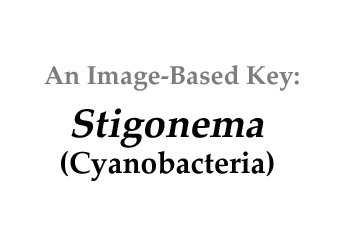|
Home / Cyanobacteria / Filaments / Branched / Stigonema |
||||
|
|
||||
 |
||||
|
Click on images for larger format |
||||
Name derivation: |
||||
|
From the Greek stigon, one who marks, and nema, thread.
|
||||
Classification: |
||||
Stigonema C.Agardh ex Bornet and Flahault 1886; 40 of 73 species descriptions are currently accepted taxonomically (Guiry and Guiry 2013).Order Nostocales; Family Stigonemataceae
|
||||
Morphology: |
||||
|
The most complex morphology of all bacteria! At least until 1927 Stigonema mammilosum was considered to be a primitive eukaryote with an unbound nucleus in the center of each vegetative cell, dividing amitotically without microtubules (Lee 1927). Filaments made of several cells in width (multiseriate), forming branches by the division of cells perpendicularly to the main filament axis (true branching). A single pit connection (plasmodesma) is reported between cells that apparently disappears in parts of the branched filament.
|
||||
Similar genera: |
||||
|
Difficult to distinguish from Fischerella, a uniseriate true-branching cyanobacterium that occupies the same habitats, although Stigonema forms branches that are typically multiseriate. Other filamentous cyanobacteria with true branching but having few multiseriate regions, including Capsosira, Hapalosiphon and Mastigocladus. |
||||
Pharmaceutical agent: |
||||
Stigonemapeptin, C48H63N9O13, a depsipeptide with elastase inhibiting activity has been isolated from Stigonema sp. from a bloom in North Nokomis Lake, WI USA (Kang et al. 2012). |
||||
Habitat: |
||||
|
Mostly found on moist rocks and in moist soil. Some species are also aquatic, epiphytic on submerged objects such as rocks, wood or lake macrophytes, or entangled in algae. It also is the primary symbiont of some lichens. At least one species forms blooms (Kang et al. 2012). Also found in Algerian hot springs (Amarouche-Yala et al. 2014). |
||||
References: |
||||
|
Amarouche-Yala, S., A. Benouadah, A.E.O. Bentabet and P. López-García 2014. Morphological and phylogenetic diversity of thermophilic cyanobacteria in Algerian hot springs. Extremophiles 18:1035-1047. Graham, L. and L. Wilcox 2000. Algae. Prentice-Hall Guiry, M.D. and G.M. Guiry 2013. AlgaeBase. World-wide electronic publication, National University of Ireland, Galway. http://www.algaebase.org; searched on 28 February 2013. Kang, H-S., A. Krunic and J. Orjala 2012. Stigonemapeptin, an ahp-containing depsipeptide with elastase inhibitory activity from the bloom-forming freshwater cyanobacterium Stigonema sp. Journal of Natural Products 75:807-811. Lee, Sybel 1927. Cytological study of Stigonema mammilosum. Botanical Gazetter 83(4):420-424. |
||||





















